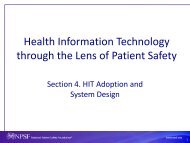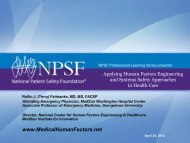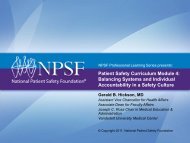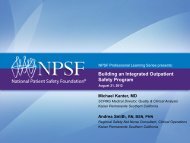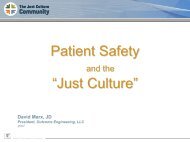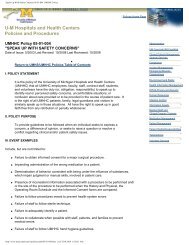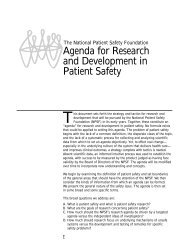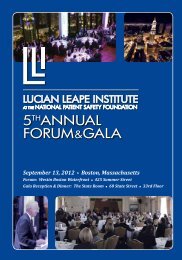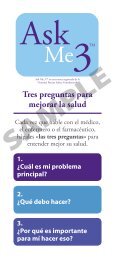Through The eyes of The Workforce - National Patient Safety ...
Through The eyes of The Workforce - National Patient Safety ...
Through The eyes of The Workforce - National Patient Safety ...
Create successful ePaper yourself
Turn your PDF publications into a flip-book with our unique Google optimized e-Paper software.
THROUGH THE EYES OF THE WORKFORCECreating Joy, Meaning, and Safer Health CareAnother aspect <strong>of</strong> psychological safety involves whether people are supported whenthings go wrong. 27 When a serious patient safety event occurs, there are two victims:the patient and the caregiver. 28 A provider who is demoralized in the wake <strong>of</strong> a seriousadverse event may be psychologically hampered from participating fully in allaspects <strong>of</strong> responding to the situation: communicating honestly and compassionatelywith the injured and frightened patient, preventing further injury, investigating thepossible causes, and analyzing and redesigning the relevant care processes. 29Lack <strong>of</strong> respect for the time <strong>of</strong> the workforce is another symptom <strong>of</strong> an injuriousworkplace. Assigning extended hours and unexpected shift changes produces fatigueand disregards the personal and family needs and schedules <strong>of</strong> the workforce. Issuingorders that interrupt workflow and attention makes it clear that the manager, or personin the gradient <strong>of</strong> hierarchy above the worker, possesses interests that are moreimportant than the planned efforts <strong>of</strong> the health care worker.Costs <strong>of</strong> Inaction<strong>The</strong> absence <strong>of</strong> cultural norms that create the preconditions <strong>of</strong> psychological andphysical safety obscures meaning <strong>of</strong> work and drains motivation. It damages everyone:doctors, nurses, employees, organizations, patients, families, as well as theeconomy. <strong>The</strong> costs <strong>of</strong> burnout, litigation, lost work hours, employee turnover, andthe inability to attract newcomers to caring pr<strong>of</strong>essions are wasteful and add to theburden <strong>of</strong> illness. 30–35More full-time employee (FTE) days are lost in health care each year than in industriessuch as mining, machinery manufacturing, and construction. 36 In addition to theharm <strong>of</strong> the individual, the constant shuffling <strong>of</strong> work schedules to adjust for workerswho have been injured takes a physical and emotional toll on every worker, exacerbatingthe constant risk <strong>of</strong> harm.Management practices, expectations, and resource limitations create conditions withmajor downstream impacts on patient safety, worker safety, and the community. 37–40Disrespectful treatment <strong>of</strong> workers increases the risk <strong>of</strong> patient injury. 41 Disrespectfultreatment <strong>of</strong> patients is also a major cause <strong>of</strong> malpractice suits that result in bothfinancial and reputational cost to organizations. 42–47All <strong>of</strong> these factors are combining to create a critical shortage <strong>of</strong> health care workers,particularly registered nurses, that will increase as the Baby Boomers age and theirhealth care needs increase. 48 In recognition <strong>of</strong> the challenges and opportunities for thenursing workforce, the Institute <strong>of</strong> Medicine has released a report titled <strong>The</strong> Future <strong>of</strong>Nursing that outlines important aims and interventions to enhance pr<strong>of</strong>essional practice,such as access to advance education and working to the top <strong>of</strong> one’s license. 4910 • CURRENT STATE OF THE HEALTH CARE WORKPLACE




